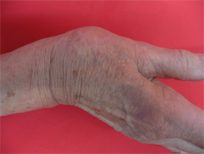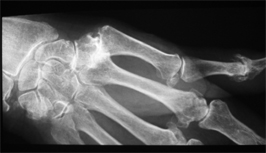


| Home | : | Biography | : | Fellowships & Awards | : | Publications | : | : | Mediation | : | Useful Links | : | Contact |
|
Thumb arthritis The thumb is the only digit that makes us different to the apes. The simian hand or monkey hand has a thumb which functions in exactly the same way as a finger. The difference in us is that we can actually oppose the thumb (bring the thumb up and over the palm towards the little finger). This movement essentially occurs at the base of the thumb at the carpo-metacarpal joint and it is this joint that most commonly gets affected by arthritis. In fact it is the second most common joint in the human body to get affected by arthritis. It more commonly occurs in females and in the age group of 50+. The ratio of women to men suffering with this is 3:1. It commonly causes a lot of pain, disability and deformity. The patients often complain of pain peeling potatoes, unscrewing jars, unscrewing door knobs rather than door handles and turning on taps. Quite commonly driving is a problem using the hand on the gear lever and even putting on clothes. On examination There is quite often a deformity with a lump at the base of the thumb which is tender and when the patient is asked where the pain is they will specifically point to that lump.  What can happen is that the thumb can move across the front of the palm and get stuck and this is what is called thumb in palm deformity. When the thumb is examined if you try and push the thumb into the palm it causes pain and if you put the hand flat on the table and try and lift the thumb off the table (retroposition) this is also painful. There is a test called the Grind test where the examiner gets hold of the thumb and tries to compress the CMCJ by pushing the thumb down towards the wrist and this is often painful and the examiner can elicit crepitus (a feeling of roughness of the joint and can be caused by bare bone rubbing against bare bone). The patient is then sent for an X-ray and the arthritis can then be graded from 1 to 4 on an Eaton and Glickel grade. Grade 1 - Widening of the joint space Grade 2 - Narrowing of the joint space and sub luxation of less than 25% and osteophytes of less than 2mm Grade 3 - Sub luxation of between 25 - 50% and osteophytes of greater than 2mm Grade 4 - Pantrapezial arthritis which means arthritis on the thumb side of the trapezium and the wrist side of the trapezium.  Treatment As with any treatment of an arthritic condition the treatment can be conservative (non-operative) or operative. |
|
